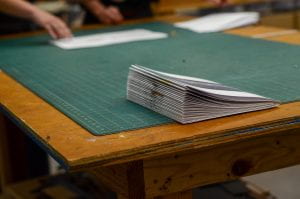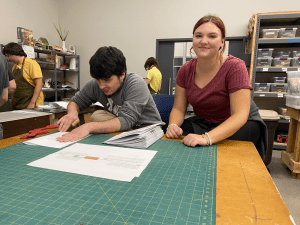How does our Press hand-craft an ambitious book of fold-out —or foldie-outtie—pages? Learn more from Production Team insider Brady Hurst!
 There is nothing that our team fears more than failing to deliver. So, once our Lower Fox River PCB Clean Up Timeline book hit our production line, we all knew that we would have our work cut out for us. Thankfully, with the bright minds at our printing press, our staff quickly formed a method to create what we now deem as “Foldie-Outtie” books. Here, we share our secrets.
There is nothing that our team fears more than failing to deliver. So, once our Lower Fox River PCB Clean Up Timeline book hit our production line, we all knew that we would have our work cut out for us. Thankfully, with the bright minds at our printing press, our staff quickly formed a method to create what we now deem as “Foldie-Outtie” books. Here, we share our secrets.
After a copy of our book is printed, our staff creates an assembly line. The pages go from the printer straight into the hands of the folding team. Each copy is shared between two staff members—and for the sake of simplicity, we named ourselves the “lefts” and “rights”. Both partners then take turns folding pages in intervals. If we were to list it would look something like: left, right, left, right, left, right… and so forth. The only difference between these two groups comes with those acting as “lefts”. Although they must also fold the paper at a quarter of an inch, they must flip their page before doing so.
 One of the nice things about being a part of the folding team is that the process itself is not too daunting, so it allows our staff to socialize with one another and get to know one another better. Whether we’re joking about our tattoos or simply picking up on the tune that someone is humming, our staff makes sure that we have fun and insert that feeling on each page.
One of the nice things about being a part of the folding team is that the process itself is not too daunting, so it allows our staff to socialize with one another and get to know one another better. Whether we’re joking about our tattoos or simply picking up on the tune that someone is humming, our staff makes sure that we have fun and insert that feeling on each page.
Once the “guts ” —or interior pages—of the book are all folded, the final page is always given to the left partner, which they don’t flip, but still fold to a quarter of an inch. All of this precision in folding is key so that when we bind the book (the next step), the fold-out pages can open, and aren’t glued into the binding.
Upon stacking the pages together in the right formation, it is sent onto our binder (named Bruce) to glue on the cover. Finally, but not least, the glued book proceeds to be trimmed to the correct book dimensions with our last machine, Robespierre—our guillotine trimmer—where it cut into its easy-to-read (and hold) size, for all to consume.

On behalf of all our team, we really hope that you enjoy this book as much as we have had making it. It has been a journey for us, and there have been times where we have talked about making our own (“Foldie-Outtie”) timeline on how to make a (“Foldie-Outtie”) book. Who knows, maybe that is a future project in the making. Either way, we truly hope you’ll enjoy the Lower Fox River PCB Clean Up Timeline, which is on sale now (click here).

